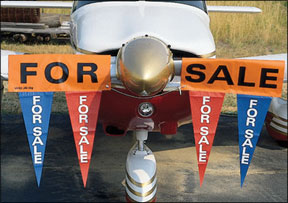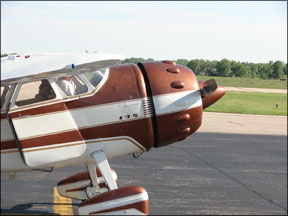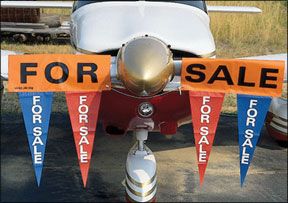Two wings. Check. Horsepower up front (or maybe in the back). Check. Liquid money in the tanks. Check. Somewhere to go? Hell, yeah!
Hang on a minute. As absurdly simple as it sounds, it is a fact that different aircraft serve different roles. Sometimes, the plane, pilot and mission dont match up any

288
more.
Its Not You, Its Me
We know how it goes. You go through primary flight training in a tame little trainer, perhaps a short-legged Cessna 152 or 172, or maybe a Piper Warrior. Youve become accustomed to the frequent fuel stops and finite loading capabilities, and know every avgas-fueled diner within 100 miles.
But maybe youve started a family, gained a baby or just want to get out of your own backyard without stopping for fuel quite as often. Maybe something faster, more comfortable, something that will get you over the terrain and out of that miserable chop. And if you need to cover half the country in a day, youll definitely need a faster ride.
Or not. If youve passed the point in your flying or professional career where you no longer need that go-fast airplane, youre a good candidate for a lower fuel burn and lower cockpit workload. Too, if your medical renewal isnt much of a gimme any more, perhaps the Sport Pilot and LSA world can open new doors to you as others close.
The thread running through each scenario is safety: Once youve determined that your plane needs to be brought in line with your mission, how will you prepare yourself to make that transition?
Trading Down
With fuel prices topping $6 a gallon across the country, it doesnt make much sense to support a larger, faster cross-country airplane when all youre doing is buying $100 hamburgers. There are safety concerns, particularly not flying enough to stay proficient, and cutting corners on preventive maintenance as your flying budget tightens. More pilots are trading down, perhaps opting for more fuel-efficient LSAs that have cross-country capabilities. As the pilot population ages, medical issues will become more prominent, making the switch to an LSA a viable option.
Scott Dyer, an ATP based out of White Plains, N.Y., points out transition training is crucial, as is time, patience and a willingness to adjust your flying practices. Downgrading isnt the slam-dunk it seems. Years back, he flew his Piper Archer into Hartford with a friend who flew 747s for a living, one who had not been in a small plane for quite a while. “On final, I could see his eyes getting bigger and bigger-it just wasnt his normal sight picture. He wanted to flare 50 feet up.”
As you retrain for a slower aircraft, its important to refresh your skills to match, especially if youve spent several thousand hours going fast. Pattern practices and approach speeds will change, and youll want to become (or stay) proficient in slow flight. Many pilots arent that comfortable at the slow end of the envelope, and that discomfort contributes to an awful lot of overrun accidents. That extra speed carried while you power down final isnt going to help; the time to bleed it off is during your approach, not while youre leaving your Dessers all over the last 500 feet of the runway.
Dyer emphasized the importance of watching approach speed, especially on modest-sized runways. “You may be the ace of the base, with the sharpest reflexes ever, but youll need to fly the aircraft within its capabilities. Pilots rightly focus on additional training when upgrading, but also need to be extraordinarily mindful when downsizing. To be a good pilot, you need to fly in harmony with the machine.”
Other issues to consider go beyond the flight. John OShaughnessy, a CFI based near Minneapolis, says a pilot who downsizes substantially often finds that its been years since he or she had to fill all the roles of a general aviation PIC, such as gathering weather, filing a flight plan, checking maintenance squawks and preflighting the aircraft.
Trading Up
As serene as it may be, that Skyhawk wont do you much good plowing westbound into 40-knot headwinds when youre on a schedule. The safety concern? Your starter plane has limits when it comes to range, payload and weather capability. Your piloting practices will need upgrading as well: When youre scorching along at 242 knots in that new Mooney Acclaim, everything happens a lot faster, and its frighteningly easy to get behind an airplane thats going as few as 40 knots faster than your old ride.
More speed and capability also brings more moving parts: retractable gear, controllable props, cowl flaps. Your checklist is more complex and time-critical, and the added capability of more sophisticated equipment, such as a G1000 or other panel glazing, requires you to create new pathways in your brain and establish new habits. A high-performance and/or complex checkout will probably ensue.
Dyer notes that faster planes give you more tools to get yourself into trouble. The plane will have greater IFR capability…but do you? And yes, you still have to slow down when you get there. It takes a while to dissipate that energy, and you need time to plan ahead for it. Hard landings, porpoising and overruns are no way to welcome your new plane to your care.
Training is key, and not just a nod and a wink to the regs. People arent computers, and it takes time and repetition to pound the learning curve into submission. Find an instructor whose training mission matches your own, and is willing to take the time to be thorough during your upgrade. They should be familiar with the model youll be flying-this is the time you want to uncover any quirks specific to your new plane. When things start to stack up at altitude, you want those unturned stones flipped over and thoroughly examined.
Missing Links
Sometimes the complexity of descent rates, Class B airspace and unfamiliar airports fade in comparison to the matrix of decisions that must be made before the purchase is made. Hidden in the increasingly regulated world of aviation are a few stretches of wilderness where the decisions are all ours. The choice of what kind of plane to transition to is not the purview of the instructor, the salesperson or (thankfully) the FAA. Its ours. That decision-making process isnt always apparent, either.
Ed Therrien started flying in Hayward, Cal., in 1955, and has logged about 12,000 hours (he stopped counting in 1993). Hes operated a repair station, has flown corporate jets, and has sold aircraft for 33 years. He weighed in on this part of the transition process:
“The majority of the decision is economic. Proficiency or training can always be dealt with if theres money to do it.” Some items to consider include the purchase of the aircraft, cost of insurance based on your experience, and the projected number of hours youre going to fly…which means the number of 100-hour inspections youre going to have for the next couple of years. Then you have maintenance costs, annuals, fuel and property taxes. If you fly IFR in the wintertime, youll need to deal with ice as well. A good rule of thumb is to add 10-15 percent to the purchase price to cover unexpected post-purchase maintenance issues.
He adds that this process includes assessing your ability as a pilot, as well as your ability to pay the insurance and other costs. “Often with the Cessna 400 series or the Navajo, a lot of insurance companies require FlightSafety training, and that adds up, too. Everything has a price tag attached to it, and you need to be honest about what you can reasonably afford. If youll only fly a few times a year, its better to rent or join a club. An airplane that doesnt fly wont remain airworthy, and your skills will deteriorate.”
Wrong Plane, Wrong Pilot
And then there are the sales that shouldnt have happened. When he had a repair

288
station in Oakland, Calif., in the 1980s, Therrien recalled a client whod roll up in an expensive car, maintained for $90 an hour, and then complain about his $35 per hour maintenance rate.
“These were the pilots who would buy an IA a $500 breakfast, followed by a pencil-whipped annual. Some of these guys didnt have a real annual for a couple of years. One of them took his whole family up to Tahoe in marginal weather-they all died when his engine blew up on him. This was a Class A example of someone who could afford an airplane, but didnt do it right. If you dont want to pay for it, or dont have the ability to pay for it, then dont do it.”
Therrien had to refuse a sale several times, where the potential customer had tunnel vision about a plane he wasnt suited for economically or skills wise. One pilot who wanted to buy a Cessna 340 had an undisclosed heart condition, and Therrien wanted no part of the sale. The pilot eventually crashed about six months later. Therriens shop had only replaced an alternator, a tire and a tie-down ring. Nonetheless, his company was included in the lawsuit, costing the insurance company over $600,000 to defend the case.
Right-Sizing
Yeah, youve put a lot of time and energy into getting your airplane like you want it. But is it really what you need?
Consider climbing the aircraft ladder in the first place. Commercial pilot and speaker Ralph Hood of Huntsville, Ala., suggests that its not always necessary. “For newer, time-building pilots I think the right airplane is the simplest airplane that will keep you happy for a while. Too many people jump from trainers to slick, powerful airplanes. Why not go from a trainer to a Skyhawk or Archer?”
Then there are the handling and maintenance quirks, some better known than others. Have you been hooked by the classic looks of a Globe Swift? ? A 10- to 15-knot crosswind may not be an issue with your Mooney, but the Swifts ride gets weird on the ground in those conditions. That may be the day that crosswind keeps you on the ground. Or, if you prefer not to sit it out that often, you may elect to bypass the Swift and commit to a more crosswind-friendly plane.
Often, the appeal of a Cessna 180/185, or even a Champ or Taylorcraft, hastens a transition sale. Even if you have a tailwheel endorsement, its well worth it to refresh your skills and rudder footwork. Dyer notes that as he built time in a Cub, he gained renewed respect for how sharp his skills had to become. “You really have to fly the airplane-its pure stick and rudder. You have to adjust your mindset. With my 210, the biggest thrill Id get was being asked for a short approach after an uneventful four-hour flight.”
The right airplane can often enable missions that werent practical before. Allen Wolpert flies out of Danbury, Conn., and has owned three aircraft in 17 years: a B36TC Bonanza, a Cessna 425 Conquest, and now a Citation CJ2. “In each upgrade I found myself not flying all of the same missions, but flying more and farther with more capability. I thought Id fly fewer hours for the same missions in a faster plane, but that hasnt been the case. Im flying more hours for the same missions, plus flying to new places.”
Conclusion
It takes a good pilot to honestly assess whether their planes match their missions, and even more so to ensure that their personal chops are up to the mission. One way to stay intellectually honest about the process is to cultivate and maintain a mentor relationship-after your initial training is over. Its important to find someone, either an instructor or a trusted peer, whose flying philosophy matches yours.
However, not all high-time pilots are immune from old wives tales, perhaps about weather knowledge or technique, so be selective in retaining whats sensible, and discard whats not.
Being realistic about the time and money it takes to stay current is a crucial piece of the puzzle. Dyer reflects, “Flying is an unforgiving business-you cant just dabble in it and stay safe. If more pilots can recognize that, fewer of them will find themselves over their heads. You can add equipment and functionality, but that doesnt make you impervious to hazards. A turbocharged plane can get you up high and fast in the smooth air, but you have to guard against becoming trapped on top of a layer, with building cumulus in front of you.”
Thats where the judgment gained from transition training, taken in anticipation of your upgraded mission, will be the most valuable tool youll bring with you. Get out and fly-your judgment wont be improved by staying on the ground. If youve got the right plane for the right mission, it could be the start-or the continuation-of a beautiful friendship.




